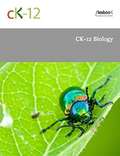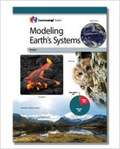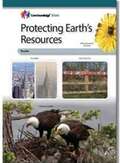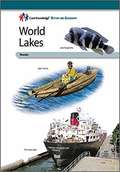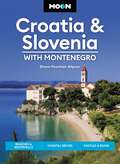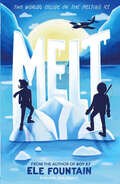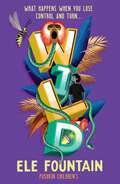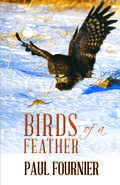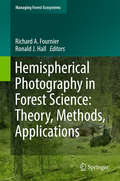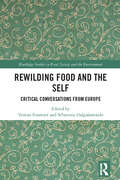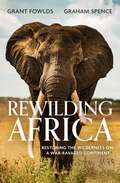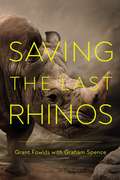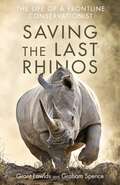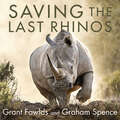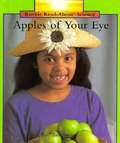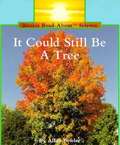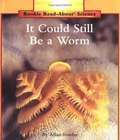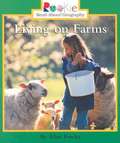- Table View
- List View
CK-12 Biology I - Honors
by Ck-12 FoundationCK-12 Foundation's Biology 1- Honors FlexBook Covers the following chapters:<P><P> Foundations of Life Science- scientific investigations, methods, observations, & communication.<P> Chemical Basis of Life- matter, the significance of carbon, lipids, proteins.<P> Cell Structure and Function- prokaryotic, eukaryotic, plant, & animal cell features; structures / functions of DNA, RNA, protein, cell transport, homeostasis.<P> Photosynthesis- water, carbon, and nitrogen cycle between abiotic and biotic resources.<P> Cellular Respiration- relation to glycolysis, Krebs Cycle, electron transport chain.<P> Cell Division and Reproduction- cell division, reproduction.<P> Mendelian Genetics- inheritance, sex-linked traits.<P> Molecular Genetics- DNA, RNA, protein synthesis, mutation, regulating gene expression.<P> Human Genetics- human genome, diseases, Biotechnology- DNA technology, gene cloning.<P> History of Life- evolution, macroevolution, extinctions, episodic speciation, response to change.<P> Evolutionary Theory- Darwin's Theory of Evolution, common ancestry and natural selection.<P> Evolution in Populations- genetics of populations, genetic diseases, natural selection.<P> Classification- Taxonomy, scientific classification of organisms.<P> Principles of Ecology- Ecology's relation with energy; ecosystems, the water, carbon, and nitrogen cycles.<P> Biomes, Ecosystems and Communities- terrestrial/ aquatic biomes, community interactions.<P> Populations- Analysis of populations and dynamics.<P> Ecology and Human Actions- Balance between humans and the earth addressing natural resources, ecosystems, & biodiversity.<P> The Human Body- systems.<P> Nervous and Endocrine Systems- structures & functions, homeostasis.<P> Skeletal, Muscular, and Integumentary Systems- structures, functions, & homeostasis.<P> Circulatory and Respiratory Systems- structures and functions.<P> Digestive and Excretory Systems- structures/ functions, food pyramid.<P> Immune System and Disease- Body defenses against pathogens.<P> Reproductive System and Human Development- human reproductive systems, reproductive lifecycle, STDs.
CK-12 Biology I (with image descriptions)
by Ck-12 FoundationOpen source biology textbook from CK-12.
Modeling Earth's Systems
by Core Knowledge FoundationModeling Earth’s Systems introduces Grade 5 students to real-world examples and fundamental concepts that will be explored in greater depth in later grades. <P><P> Students will apply their background knowledge to develop models of the different “spheres” of the Earth and use their models to discuss how different systems interact. Examples for students include: the influence of the ocean on ecosystems, landform shape, and our climate; the influence of the atmosphere on landforms and living things; and the influence of mountains on weather patterns such as winds and clouds in the atmosphere. <P><P> As part of this unit, students are tasked to create a graphical representation of the amounts of fresh water versus saltwater on the Earth and indicate where these sources of water are typically found.
Protecting Earth's Resources
by Core Knowledge FoundationProtecting Earth’s Resources introduces Grade 5 students to real-world examples and fundamental concepts that will be explored in greater depth in later grades. Students will research efforts that many communities take to reduce the impacts of using natural resources. Using their knowledge of how water, air, and land are used for daily needs, students create a series of action/protection plans, which they will have the option to present to a selected audience of experts. Each part of this unit engages students to learn of specific natural resources used to meet human needs and how communities work to minimize any negative effects of use.
World Lakes (Core Knowledge History and Geography)
by Core Knowledge FoundationWORLD LAKES begins with a review of map skills and geographical terms. Students learn about the benefits and resources provided by lakes, including, in Asia, the Caspian and Aral Seas; in Africa, Lakes Victoria, Tanganyika, and Chad; in South America, Lakes Maracaibo and Titicaca; and, in North America, Lakes Superior, Huron, Michigan, Erie, and Ontario.
Moon Croatia & Slovenia: Beaches & Waterfalls, Coastal Drives, Castles & Ruins (Travel Guide)
by Shann Fountain AlipourSun-drenched villages and warm beaches, thick forests and snow-capped mountains: Immerse yourself in a postcard come to life with Moon Croatia & Slovenia. Inside you'll find: Flexible itineraries from one week in each country to two weeks in both, including a side trip to Montenegro, plus how to make the most of short stays in Zagreb, Dubrovnik, and Ljubljana Suggestions for a Dalmatian Islands getaway and other day trips to escape the city crowds Must-see highlights and unique experiences: Go truffle hunting in Istria or taste homemade vintages on an ancient wine route. Walk along the creamy stone and red-tiled roofs inside Dubrovnik's 15th-century walls or wander through Ljubljana's historic Tivoli Park. Leave crowded beaches behind and hire a boat to explore lesser-known islands. Wind your way up snowy Mount Sljeme, hike to caves and waterfalls in Croatia's Plitvice Lakes National Park or go rafting in Slovenia's Soca River Expert insight on when to go, what to do, and where to stay from former Zagreb local Shann Fountain Alipour Full-color photos and detailed maps throughoutBackground information on the landscape, history, and cultural customs of each country Handy tools such as visa information, Croatian, Slovenian, and Montenegrin phrasebooks Experience Croatia & Slovenia your way with Moon's practical tips and local insight. Looking for more sunshine? Try Moon Amalfi Coast. Heading east? Check out Moon Prague, Vienna & Budapest. About Moon Travel Guides: Moon was founded in 1973 to empower independent, active, and conscious travel. We prioritize local businesses, outdoor recreation, and traveling strategically and sustainably. Moon Travel Guides are written by local, expert authors with great stories to tell—and they can't wait to share their favorite places with you. For more inspiration, follow @moonguides on social media.
Melt: A breathless adventure story of courage and survival in a warming climate
by Ele FountainA breathless adventure story of courage and survival in a warming climate, from the multi-award-winning author of Refugee 87Yutu lives in a remote Arctic village with his elderly grandmother. Their traditional way of life is threatened by the changing snow and ice, which melts faster every year.Bea is trying to adapt to yet another new school. Worse still, her father's new job takes up any spare time, and his behaviour has become odd and secretive. On a trip she hopes will fix things, their fates take a drastic turn and Bea's life becomes entwined with Yutu's in a way she could never have imagined.Together, they become locked in a desperate race for survival.
Wild: A gripping rainforest adventure from the multi award-winning author of Refugee 8 7
by Ele FountainA moving, page-turning novel about a family's grief and the crisis afflicting the rainforest, from the prize-winning author of Refugee 87Ever since Jack's dad died, he's had a heavy feeling inside. The pressure keeps building. Looking for release, he starts skiving school and hanging around with a group who like to cause trouble. It's easy to hide his new habits from his mum, an environmental anthropologist, because she's too busy with work and conservation trips to notice.As Jack spins further out of control, his mum eventually becomes concerned – and shocks him by suggesting a trip together.But this will be no relaxing holiday. Soon Jack finds himself on an expedition deep into the rainforest, far from anything he's ever known. He wanted an adventure – but has he plunged into real danger?
Birds of a Feather
by Paul FournierIn this new collection, Maine guide, bush pilot, journalist, and professional photographer Paul Fournier spins more stories of the wild outdoors in the inimitable style that earned him the Best Book of 2011 Award from the New England Outdoor Writers Association for Tales from Misery Ridge. In the title essay, Fournier tells the fascinating story of how devoted scientists, citizens, and outdoor professionals brought back the bald eagle in Maine one nesting pair at a time. Other tales strike a similar vein: a group of volunteers and biologists strive to save the rare Arctic char in a remote Maine lake, the author attempts to spy a cougar in Maine, and he and a friend find a daring way to film a world famous clowning skier's downhill run in one "take." Among his adventures and misadventures over the decades, Fournier covers the Sonny Liston/Mohammed Ali fight in Lewiston, gets perilously close to a rutting moose, and witnesses how a pair of deer poachers are literally caught in their own trap. Experienced outdoorsmen in particular will nod with appreciation and pleasure at the author's experiences, and armchair explorers will enjoy his entertaining essays about the strange habits of forest fauna. This diverse collection of stories finds its unity in the author's humor, authority, and love of his subjects: Maine and its wild and civilized inhabitants, whether they climb, slink, swim, fly--or walk on two feet.
Hemispherical Photography in Forest Science: Theory, Methods, Applications
by Richard A. Fournier Ronald J. HallThis book presents practical information about hemispherical photography from the perspectives of field data acquisition, image processing and information retrieval methods. This book is organized into three sections. The first section describes what is hemispherical photography and what are the fundamental elements of forest structure and light interactions within the forest canopy. The second section provides practical information about the equipment, procedures and tools for procuring, processing and analyzing hemispherical photographs. Armed with this information, the third section describes several applications of hemispherical photographs to forestry and natural resource assessment. The book concludes with a discussion about modelling tools and future directions of this rapidly growing field. There is currently no information source on the market that has this comprehensive range of topics combined in a single book. The book will appeal to academics, graduate students, natural resource professionals and researchers alike.
Rewilding Food and the Self: Critical Conversations from Europe (Routledge Studies in Food, Society and the Environment)
by Tristan Fournier Sébastien DalgalarrondoThis volume contributes to the return to nature movement that is very much in vogue in contemporary European societies, by examining the place of food and eating in the "rewilding" process. It is divided into three parts, each of which consists of conversations between social scientists, with fieldwork collected from across Denmark, Finland, France, Italy, Norway and Switzerland. The first part focuses on the ways in which the hunter-gatherer livelihood has been transformed into a resilient, simpler and ecological way of life. It is dedicated to hunting and identifies the contexts in which large wild game meat is consumed and the reasons why such a product is still valued today. The second part shows how some practices that aim to reconnect with natural processes are developing within a market economy. Case studies on natural wine and fasting retreats help us to identify the promises that producers and promoters are relying on in order to disseminate them. Finally, the third part considers how this process of rewilding food is expressed in post-modernity. By focusing on two normative frameworks in which the rhetoric of the wild is mobilized although it is not expected to be in these terms – urbanity and the gender order – the goal is to understand the extent to which referring to the wild in food discourses and practices contributes to challenging our identities, and to creating possible forms of emancipation. This book will be of great interest to students and scholars interested in food cultures, human nature relationships, and sustainable diets.
Rewilding Africa: Restoring the Wilderness on a War-ravaged Continent
by Grant Fowlds Graham SpenceConservationist Grant Fowlds lives to save and protect Africa's rhinos, elephants and other iconic wildlife, to preserve their habitats, to increase their range and bring back the animals where they have been decimated by decades of war, as in Angola, Mozambique and the Democratic Republic of the Congo. This vivid account of his work tells of a fellow conservationist tragically killed by the elephants he was seeking to save and a face-off with poachers, impoverished rural people exploited by rapacious local businessmen. Fowlds describes the impact of the Covid pandemic on conservation efforts, the vital wildlife tourism that sustains these and rural communities; and tells of conservationists' efforts to support people through the crisis. Lockdowns may have brought a welcome lull in rhino and other poaching, but also brought precious tourism to a standstill. He shows how the pandemic has highlighted the danger to the world of the illicit trade in endangered wildlife, some of it sold in 'wet markets', where pathogens incubate and spread. He describes a restoration project of apartheid-era, ex-South African soldiers seeking to make reparations in Angola, engulfed for many years in a profoundly damaging civil war, which drew in outside forces, from Cuba, Russia and South Africa, with a catastophic impact on that country's wildlife. Those who fund conservation, whether in the US, Zambia or South Africa itself, are of vital importance to efforts to conserve and rewild: some supposed angel-investors turn out to be not what they had appeared, some are thwarted in their efforts, but others are open-hearted and generous in the extreme, which makes their sudden, unexpected death an even greater tragedy. A passionate desire to conserve nature has also brought conservationists previously active in far-off Venezuela to southern Africa. Fowlds describes fraught meetings to negotiate the coexistence of wildlife and rural communities. There are vivid accounts of the skilled and dangerous work of using helicopters to keep wildebeest, carrying disease, and cattle apart, and to keep elephants from damaging communal land and eating crops such as sugar cane. He tells of a project to restore Africa's previously vast herds of elephants, particularly the famed 'tuskers', with their unusually large tusks, once prized and hunted almost to extinction. The range expansion that this entails is key to enabling Africa's iconic wildlife to survive, to preserving its wilderness and, in turn, helping humankind to survive.There is a heartening look at conservation efforts in Mozambique, a country scarred by years of war, which are starting to bear fruit, though just as a new ISIS insurgency creates havoc in the north of the country. What will humanity's relationship with nature be post-pandemic? Will we have begun to learn that by conserving iconic wildlife and their habitats we help to preserve and restore precious pockets of wilderness, which are so vital not only the survival of wildlife, but to our own survival on our one precious planet.
Rewilding Africa: Restoring the Wilderness on a War-ravaged Continent
by Grant Fowlds Graham SpenceConservationist Grant Fowlds lives to save and protect Africa's rhinos, elephants and other iconic wildlife, to preserve their habitats, to increase their range and bring back the animals where they have been decimated by decades of war, as in Angola, Mozambique and the Democratic Republic of the Congo. This vivid account of his work tells of a fellow conservationist tragically killed by the elephants he was seeking to save and a face-off with poachers, impoverished rural people exploited by rapacious local businessmen. Fowlds describes the impact of the Covid pandemic on conservation efforts, the vital wildlife tourism that sustains these and rural communities; and tells of conservationists' efforts to support people through the crisis. Lockdowns may have brought a welcome lull in rhino and other poaching, but also brought precious tourism to a standstill. He shows how the pandemic has highlighted the danger to the world of the illicit trade in endangered wildlife, some of it sold in 'wet markets', where pathogens incubate and spread. He describes a restoration project of apartheid-era, ex-South African soldiers seeking to make reparations in Angola, engulfed for many years in a profoundly damaging civil war, which drew in outside forces, from Cuba, Russia and South Africa, with a catastophic impact on that country's wildlife. Those who fund conservation, whether in the US, Zambia or South Africa itself, are of vital importance to efforts to conserve and rewild: some supposed angel-investors turn out to be not what they had appeared, some are thwarted in their efforts, but others are open-hearted and generous in the extreme, which makes their sudden, unexpected death an even greater tragedy. A passionate desire to conserve nature has also brought conservationists previously active in far-off Venezuela to southern Africa. Fowlds describes fraught meetings to negotiate the coexistence of wildlife and rural communities. There are vivid accounts of the skilled and dangerous work of using helicopters to keep wildebeest, carrying disease, and cattle apart, and to keep elephants from damaging communal land and eating crops such as sugar cane. He tells of a project to restore Africa's previously vast herds of elephants, particularly the famed 'tuskers', with their unusually large tusks, once prized and hunted almost to extinction. The range expansion that this entails is key to enabling Africa's iconic wildlife to survive, to preserving its wilderness and, in turn, helping humankind to survive.There is a heartening look at conservation efforts in Mozambique, a country scarred by years of war, which are starting to bear fruit, though just as a new ISIS insurgency creates havoc in the north of the country. What will humanity's relationship with nature be post-pandemic? Will we have begun to learn that by conserving iconic wildlife and their habitats we help to preserve and restore precious pockets of wilderness, which are so vital not only the survival of wildlife, but to our own survival on our one precious planet.
Saving the Last Rhinos: The Life Of A Frontline Conservationist
by Grant Fowlds Graham SpenceThe remarkable story of Grant Fowlds, who has dedicated his life to saving the imperiled rhinos, vividly told with Graham Spence, co-author of the bestselling The Elephant Whisperer.What would drive a man to &‘smuggle&’ rhino horn back into Africa at great risk to himself? This is just one of the situations Fowlds has put himself in as part of his ongoing fight against poaching, in order to prove a link between southern Africa and the illicit, lucrative trade in rhino horn in Vietnam. Shavings of rhino horn are sold as a snake-oil &“cures,&” but a rhino&’s horn has no magical, medicinal properties whatsoever. Yet it is for this that rhinoceroses are being killed at an escalating rate that puts the survival of the species in jeopardy. This corrupt, illegal war on wildlife has brought an iconic animal to the brink of extinction. Growing up on a farm in the eastern Cape of South Africa, Grant developed a deep love of nature, turning his back on hunting to focus on saving wildlife of all kinds and the environment that sustains both them and us. He is a passionate conservationist who puts himself on the front line of protecting rhinos in the wild—right now, against armed poachers—and in the long term, through his work with schoolchildren, communities, and policymakers.
Saving the Last Rhinos: The Life of a Frontline Conservationist
by Grant Fowlds Graham SpenceThe remarkable story of Grant Fowlds, a conservationist who has dedicated his life to saving the last rhinos, vividly told with the help of Graham Spence, co-author of the bestselling The Elephant Whisperer.'A terrific read . . . an outstanding book!'Gary Player and Vivienne Player'A truly heart-wrenching story, but a must-read for all who value our wild animals and their right to roam free. Grant Fowlds is a Zulu in a white skin and loves the people who hold the key to animal conservation. This is an intriguing true story that sends a clear message to the rest of the world.'Phil Liggett'Exceptionally readable - a fluid and captivating story . . . a swashbuckling tale.'Dr Dave Cooper, Rhinos Without Borders veterinarian, and Debbie Cooper of iSimangaliso Wetland Park'A rollicking true-life adventure that celebrates rhinos and people'Guy Rogers, Daily Herald'Truly awe-inspiring . . . Read this book. You will get a sense of Africa like never before, from a true African soul.'David S. Lee, Limbani in the blockbuster movie Black Panther'An excellent read . . . both sobering and uplifting'Moira Smith, General Manager Africa & Middle East, Goway TravelWhat would drive a man to 'smuggle' rhino horn back into Africa at great risk to himself? This is just one of the situations Grant Fowlds has put himself in as part of his ongoing fight against poaching, in order to prove a link between southern Africa and the illicit, lucrative trade in rhino horn in Vietnam.Shavings of rhino horn are sold as a snake-oil 'cure' for colds or impotence, but a rhino's horn has no magical, medicinal properties. It is for this that rhinoceroses are being killed at an escalating rate that puts the survival of the species in jeopardy. This corrupt, illegal war on wildlife has brought an iconic animal to the brink of extinction.Growing up on a farm in the Eastern Cape of South Africa, Grant developed a deep love of nature, turning his back on hunting to focus on saving wildlife of all kinds and the environment that sustains both them and us. He is a passionate conservationist who puts himself on the front line of protecting rhinos in the wild - right now, against armed poachers; but in the longer term, too, through his work with schoolchildren, communities and policymakers.We are most grateful to photographer Gerhard van der Westhuizen for the use of his stunning photograph on the cover of the book.
Saving the Last Rhinos: The Life of a Frontline Conservationist
by Grant Fowlds Graham Spence'A terrific read . . . an outstanding book!'Gary Player and Vivienne Player'A truly heart-wrenching story, but a must-read for all who value our wild animals and their right to roam free. Grant Fowlds is a Zulu in a white skin and loves the people who hold the key to animal conservation. This is an intriguing true story that sends a clear message to the rest of the world.'Phil Liggett'Exceptionally readable - a fluid and captivating story . . . a swashbuckling tale.'Dr Dave Cooper, Rhinos Without Borders veterinarian, and Debbie Cooper of iSimangaliso Wetland Park'A rollicking true-life adventure that celebrates rhinos and people'Guy Rogers, Daily Herald'Truly awe-inspiring . . . Read this book. You will get a sense of Africa like never before, from a true African soul.'David S. Lee, Limbani in the blockbuster movie Black Panther'An excellent read . . . both sobering and uplifting'Moira Smith, General Manager Africa & Middle East, Goway TravelWhat would drive a man to 'smuggle' rhino horn back into Africa at great risk to himself? This is just one of the situations Grant Fowlds has put himself in as part of his ongoing fight against poaching, in order to prove a link between southern Africa and the illicit, lucrative trade in rhino horn in Vietnam.Shavings of rhino horn are sold as a snake-oil 'cure' for colds or impotence, but a rhino's horn has no magical, medicinal properties. It is for this that rhinoceroses are being killed at an escalating rate that puts the survival of the species in jeopardy. This corrupt, illegal war on wildlife has brought an iconic animal to the brink of extinction.Growing up on a farm in the Eastern Cape of South Africa, Grant developed a deep love of nature, turning his back on hunting to focus on saving wildlife of all kinds and the environment that sustains both them and us. He is a passionate conservationist who puts himself on the front line of protecting rhinos in the wild - right now, against armed poachers; but in the longer term, too, through his work with schoolchildren, communities and policymakers.We are most grateful to photographer Gerhard van der Westhuizen for the use of his stunning photograph on the cover of the book.
Apples of Your Eye
by Allan FowlerDescribes all of the wonderful food you can make from the different varieties of apples.
Gator or Croc?
by Allan FowlerFrom friendly dolphins to giant pandas, from icebergs and glaciers to energy from the sun, from magnets to solids, liquids, and gases, Rookie Read-About Science is a natural addition to the primary-grade classroom with books that cover every part of the science curricula. Includes: animals, nature, scientific principles, the environment, weather, and much more!
How Do You Know It's Spring?
by Allan FowlerHow do you know it's spring? When leaves begin to grow on the trees... when the grass turns green again... when the first flowers bloom in your garden or in the park, then you know it's springtime!
It Could Still Be a Tree
by Allan FowlerThe book goes through many different species of trees and identifies their discerning qualities.
It Could Still Be A Flower
by Allan FowlerFrom friendly dolphins to giant pandas, from icebergs and glaciers to energy from the sun, from magnets to solids, liquids, and gases, Rookie Read-About Science is a natural addition to the primary-grade classroom with books that cover every part of the science curricula. Includes: animals, nature, scientific principles, the environment, weather, and much more!
It Could Still Be A Worm
by Allan FowlerFrom friendly dolphins to giant pandas, from icebergs and glaciers to energy from the sun, from magnets to solids, liquids, and gases, Rookie Read-About Science is a natural addition to the primary-grade classroom with books that cover every part of the science curricula. Includes: animals, nature, scientific principles, the environment, weather, and much more!
Living On Farms
by Allan FowlerA simple introduction to the history, animals, machines, products, and importance of farms. The popular Rookie Books expand their horizons - to all corners of the globe! With this series all about geography, emergent readers will take off on adventures to cities, nations, waterways, and habitats around the world. . . and right in their own backyards.


